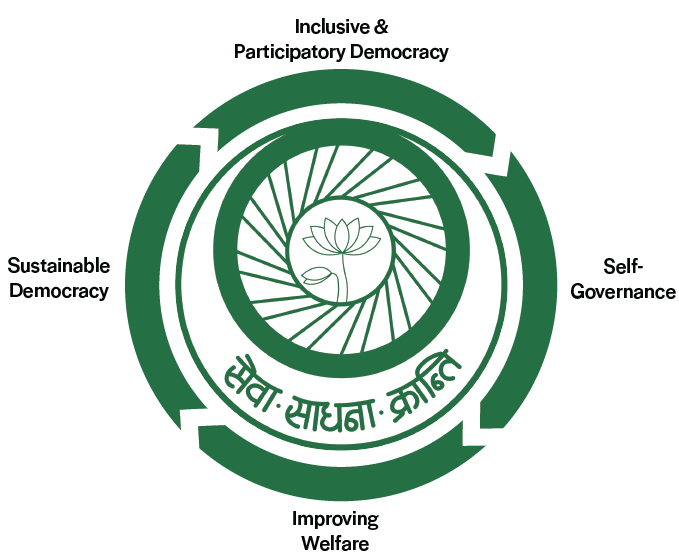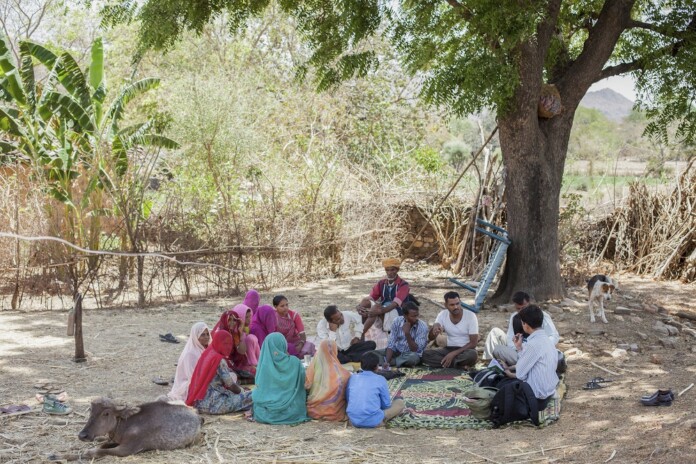Seva Mandir has come to be recognised for its deep community work and its introspective culture. Incorporated in 1967, it made a conscious choice to stay focused on southern Rajasthan and has developed strong insights into community development. While its direct engagement is with 1,300 villages in two districts of south Rajasthan, Seva Mandir has impacted the development discourse at the national and international levels.
The core of Seva Mandir’s approach has been the belief that change from within is the most essential ingredient for building a more just, equal and caring society. This inner transformation is the sadhana (sustained practice) that has been a constant in the organization. Another core element of Seva Mandir’s approach has been its belief that constructive work is the most enduring lever for change. Hence, service or seva, has been a strong thread that has run through all its efforts – whether it is in terms of running a preschool centre or doing community forestry. This requires a community to work on constantly holding each other to account, ensuring equity in efforts and rewards as well as transparency in operations. Seva and Sadhna thus go hand-in-hand for Seva Mandir, each remaining incomplete without the other.
Both Seva and Sadhna are in some way incomplete if they do not ultimately lead to Kranti (defined as a deep/significant change in the way things are done or organised). In that respect, Kranti is the only one in this triad who is both an intervention and an outcome.
Some of the lasting contributions by Seva Mandir to the development landscape in the country include – pioneering efforts in adult education, people’s movement around afforestation and bringing communities together around common lands, innovating the concept of the Gram Vikas Kosh (Village Development Fund) as a nucleus of community cohesion and autonomy.

Building ‘social capital’ has been both a means and an end for Seva Mandir. In almost all its programmes, Seva Mandir attempts to bring in a community dimension. The Gram Vikas Kosh thrived by involving beneficiary families in contributing to a shared fund from immediate wages and long-term productivity gains. It evolved into a virtual ‘commons’ embedding democratic values and empowering villages with financial autonomy.
Seva Mandir’s approach establishes the principle of non-exclusivity – that it is not just inspired leaders, but every one of us who can and must contribute to building a better society.
Seva Mandir also realised early that constraints to development come not only from the outside (such as through policies or lack of resources), but also from inside. Seemingly homogenous tribal communities were also divided internally, eroding their ability to cooperate or hold others to account. These internal contradictions were factored into the way the organisation approached its work of rebuilding communities.
Even though everyone would agree that it’s not possible to succeed all the time, yet, somehow the discourse among civil society organisations is mostly centred around successes. However, Seva Mandir was able to build a microculture where honest reflection was the norm, not just internally but also with its donors and supporters, or with visitors.
This helped build some truly strong programmes, especially in the areas of natural resources development, education and building community institutions. Acknowledgement of its failures and a constant review of its own beliefs and interventions have enabled Seva Mandir to remain relevant and adaptive to the constantly changing context.
Two key external factors that helped Seva Mandir enormously in its work have been the rootstock of social capital that exists in tribal communities, and a set of exceptional donors during a critical phase of the organization’s evolution. Some enlightened donors introduced a completely different paradigm of partnering by asking Seva Mandir to make its own full and comprehensive plan for three years. Seva Mandir seized this opportunity and put in place processes whereby every village developed its plan and budgets, which were then factored into a larger goal and direction.
Looking back can be both easy and difficult – there is hindsight-enabled clearer vision and one can forget the reality of actions and decisions taken while being on the ‘dance floor’.
There are tensions related to conversations around the positions of ethics and morality of the sector’s functioning, especially when there are overlaps with other non-profits working in similar geographies or domains. The balance between constructive work and the struggle for rights, the elusive balance between Seva and Kranti, is another area the organisation has grappled with.
The work of organizations such as Seva Mandir is ultimately located in the space of community aspirations and beliefs, with an attempt to both understand those aspirations and influence them. Most of Seva Mandir’s focus was on strengthening options in the village (through forestry, agriculture and even some small enterprise development), and it kept receiving positive reaffirmation on this direction from the communities. However, the reality was also that migration continued to increase. Often when communities sense a wider chasm between their belief systems and those of the outside agency—and where they feel that engagement may only lead to disharmony—a kind of ‘weapons of the weak’ syndrome begins to work in the shape of overt agreement and acquiescence. There is no sure way to avoid this, except to keep working on one’s ability to listen and look beyond one’s own perspectives.
Another dilemma has been – where do the boundaries of the institution end and where does it merge into the society it is a part of? Does an organization (especially one like Seva Mandir which is trying to bring about social change) worry only about how people behave within its institutional boundaries or should it also worry about how they behave beyond the organizational boundaries? Being conscious of this has led to Seva Mandir adopting more of an approach of reform (and not just a punitive one). This has resulted in the creation of a far more caring organizational environment and has led to (maybe) values which have permeated into spaces beyond the institution.
Seva Mandir’s experience suggests that there is a need for a paradigm shift in the way we think about development. It is not enough for the government to make large allocations of funds for poverty alleviation and rural development. What is needed is that villagers themselves and civil society be empowered to play a significant role in the conceptualisation, execution, and governance of development. In this approach of autonomous development, the differences in education and class backgrounds can give way to more wholesome identities of shared purpose.
At another level, Seva Mandir also realised that those who are oppressed are often complicit in their exploitation. They tolerate the poor quality of public services—such as health provision, education and stable property rights—as well as the arbitrary behaviour of the authorities. They often seek benefits to which they are not entitled and thereby bend to those in power rather than seeking to transform their relationships. Realigning self-interest so that it supports, rather than undercuts, the common good is the challenge for development, not just improving individual well-being in terms of health, education and income. Seva Mandir has found that constructive work programmes can bring this change. It, however, needs time, patience and a vision for development that acknowledges the damage being done by development sans democracy.
This blog is a summary of a chapter written by Neelima Khetan in “Anchoring Change: Seventy-five years of Grassroots Interventions that Made a Difference” edited by Vikram Singh Mehta, Neelima Khetan and Jayapadma RV, published by Harper Collins India. The book is a recipient of the GLF Honour Award 2023.
The chapter summary has been prepared by Jayapadma RV.










